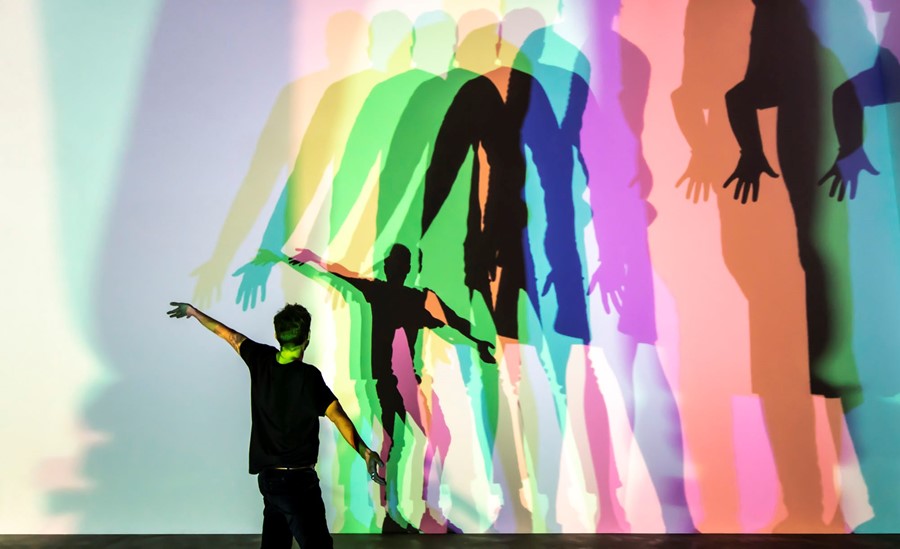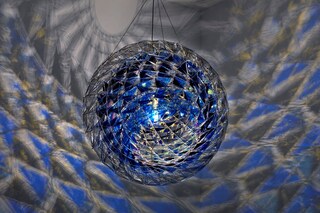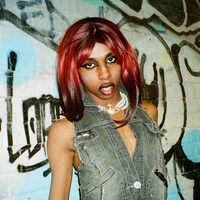We speak to Tate Modern curator Mark Godfrey about the importance of truly experiencing the artist’s work
“To make art, for me, means to be in dialogue with the world. People may not always like my ideas or artworks, but even so I am acknowledged as a speaker, as a contributor, which makes me feel I’m part of the times I live in. This is crucial to me, because it allows me to be conscious of my own existence.”
It’s this quote that I read in Danish-Icelandic artist Olafur Eliasson’s Phaidon-published monograph, Experience, that’s on my mind as I enter the Tate Modern to see his just-opened retrospective, In Real Life. Eliasson’s art reminds you that you are physically present, that you are a body, not just a mind. As you move through his works, you’re often forced to creep around the wall-to-wall circular sculpture “How Do We Live Together” (2019), walk into a giant kaleidoscope (‘Your Spiral View’, 2002), or edge through “Din Blinde Passager (Your Blind Passenger)” (2010), a 39-metre long room filled with fog and coloured lights.
Eliasson is an artist who says ‘feelings are facts’. He asks the audience to be a co-producer of the work and thus places experience in the centre of his practice, employing not just sight, but sound, touch, smell, and even taste. While much of his work appears to lend itself to our insatiable appetite for experience culture and the need to document it and share it with others online, the years of which many of these were created often long predate social media. In fact, despite the picturesque qualities, his art is best experienced offline and in real life – which is perhaps why Eliasson and Tate Modern Senior Curator Mark Godfrey decided to name it just that. With In Real Life having launched at the London institution this weekend, we speak with Godfrey about the importance of stepping out from behind our screens to experience, and feel, art in real time.
“He gives people a chance to have a very sensory experience... It’s not just about information, it’s about touching, hearing, seeing, smelling, and tasting” – Mark Godfrey
This is a huge show – over 40 works. Were there any themes that you were following when you were deciding on what to include?
Mark Godfrey: Instead of having a focus on one of the key themes in Olafur’s work we wanted to have a whole range, and that meant going back to 1990, to works he was making when he was still in art school. There are also five or six brand new works that have debuted at the show. With this 30 year span of work, there have been three main strands of interest. One is nature; works that might be a waterfall, the ‘Moss Wall’ (1994), or the Glacier series (1999). Another is geometry; the kaleidoscopes such as ‘Cold Wall Sphere’ (2012). And another is perception – well, all his works involve perception – but works like the fog tunnel (‘Din Blinde Passenger/Your Blind Passenger’, 2010) or ‘Big Bang Fountain’ (2014). Works that deal with how you perceive (things), the ‘after image’ of them, and the sense you have when you’re with them that makes you more aware of your senses.
We also wanted to look at the interest he has that goes his social business, his campaigns, which meant devoting a space within the show, or what we call the ‘expanded studio’, that looks at the intellectual labour of the studio, and the research that goes on there. Works like ‘Ice Watch’ (2014/2018). The last thing is in respect to the role that the kitchen plays in the studio in Berlin, the importance that food-related issues play. We set up a collaboration between the Tate restaurant and his studio kitchen so that some people might come to the exhibition and then go and have lunch, and get a sense of the organic, vegetarian food that is served in Olafur’s studio every day.
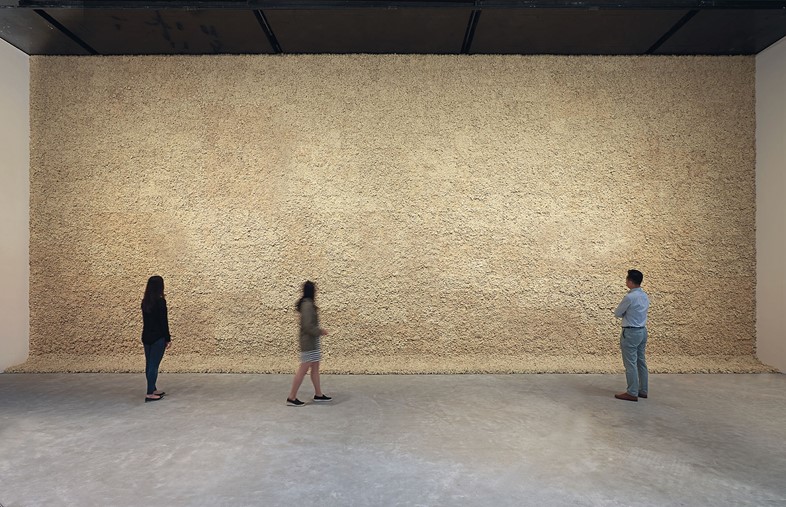
One of Olafur’s strands of beliefs is ‘feelings are facts’. You write in your essay in the show’s catalogue that feelings could lead to action, and that Olafur believed this was the reason to create art. Do you think there’s a responsibility placed on the viewer to act after they’ve viewed his works?
Mark Godfrey: No, I don’t think he would place on them the responsibility to act. It’s more that he thinks when you are in a space with other people, you become more conscious of yourself as a sensing person and as a social person in a space with other people. But those two things combined, and the feelings you have in that space with other people, make you more aware of your body, for instance. Or your eyesight and the awareness might lead to a great sense of responsibility. It’s a very abstract series of thoughts and it’s not directly to say that he wants to make people feel responsible but he does think that can be an effect of art. I know it’s a big claim to make, and some people will dispute it – you look into the kaleidoscope and see your reflection but that doesn’t add up to a great sense of responsibility. But some people would accept his claims. As a curator, it’s not really our role to say whether or not these claims are true or not, but we can present them and the work as best we can. And be clear to people that what he believes his work does, or his highest ambitions of the work, of feeling and responsibility, people can assess those claims for themselves.
When I went through the fog room (‘Der Blinde Passager/Your Blind Passenger’, 2010), that’s when I really attached feeling to the work, you can’t escape your senses when experiencing something like that.
Mark Godfrey: Fog comes from being in nature but also works with perception. If I were to ask you, immediately after you left, what colours you saw in there, you may have said you saw blue. But there is no blue light – the blue light comes from your eyes compensating for the yellow that you’ve just been in. There are two lights; yellow and white. The blue is an ‘after image’.
That space is also interesting because of his interest in ‘we-ness’. What it means to form a ‘we’ and have a heightened sense of being with other people. In the fog corridor, you have a very different sense of being close to other people than you would on a crowded tube carriage. That’s the same with a lot of his works.
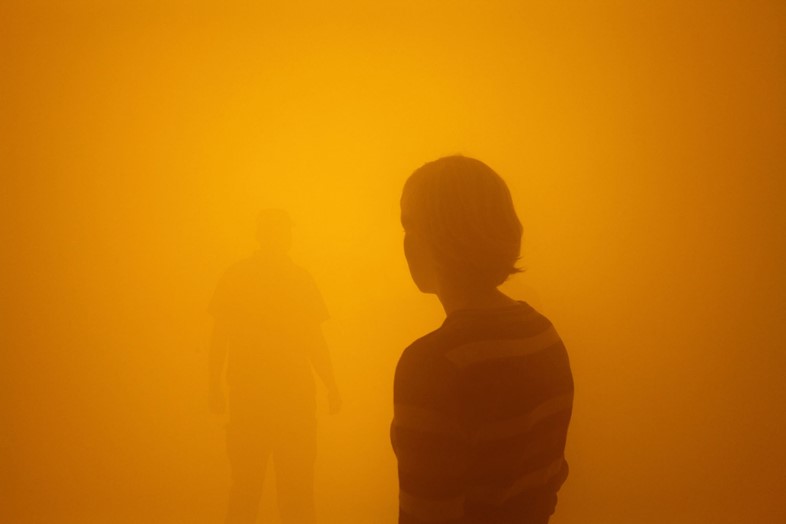
Many of Olafur’s works were created previous to a new age of how we experience art, which is through our phones. How does this idea of ‘experience culture’ interact with Olafur’s work?
Mark Godfrey: Well, there’s a long history that art is an experience and one which you can have an immersive experience with. That really kicked in in the mid-60s and Olafur draws off of different histories of other artists doing that, but he does it in a different historical moment where how we think about how experience has changed a lot because of how many experiences are mediated more and more.
I’ve spent a lot of time talking to him about it. Many of these works (‘Moss Wall’, ‘Beauty’, the first waterfalls, ‘The Weather Project’) all predate handheld phones with cameras on them. So one of the questions Olafur is dealing with right now is what happens when you present these works to an audience which experiences them with their phone out. What is lost and what is gained? I think he’s very ambivalent about that because on the one hand, I’ve been with him to many places and he’s the first person to take a selfie and enjoy playing with a camera – just like myself, that’s what we do. We enter a space aware of the phone in our pocket. It’s very quick to pull out your phone and take a selfie and I don’t think he’s critical of people who do that but there is a sense that it’s not the only way to experience (it) and that if that is the only way to experience it then something does get lost. I‘d say experiencing his works with your phone is not something to be looked down upon, but it’s also not something that can replace experiencing his work without your phone. But because that’s what everyone does now, I think he has to think, and is thinking, about what that means.
An interesting thought because the title itself is In Real Life, can you expand on what that means?
Mark Godfrey: There are two ramifications for this. The first comes out of the phrase ‘IRL’ and the idea that you do have to experience this in real life. Seeing pictures of the show on Instagram or whatever platform is not a replacement from actually being in the space with your phone. Once you're in the space, walking through ‘Passenger’ or smelling the ‘Moss Wall’, those experiences unfold with your senses over time more than any image could. The second idea is that his practice takes place in the real world and not in just forms and colours, but he addresses the real world of migration, solar power, renewable energy or climate emergency. There may be many artists concerned primarily about colour, who aren’t necessarily thinking about the world we live in but he’s thinking about both.

There are some big political issues that he does touch upon such as migration and climate change. Can you talk more about the Glacier series, one is a series of images he shot of glaciers in Iceland in 1999 and the other is the same glaciers shot in 2019.
Mark Godfrey: Halfway through the show, we’re going to take down the 1999 ones and replace them with new images. Iceland has always been important to Olafur and in 1999 he worked with a farmer who had a small plane and flew over, I think, 42 different glaciers, photographing their tongues. He’s now back there doing the same thing again. He showed me the first photograph a few weeks ago and showed me it next to the one on the wall, and you can see the difference between them. It’s quite startling and scary. So that’s going to come into the show later.
With ‘Ice Watch’, you can see the ice melting in real time.
Mark Godfrey: ‘Ice Watch’ is the clearest way of trying to explain this idea of ‘feelings are facts’. Olafur would say that we are often presented with information about the climate emergency through a discourse of fear and catastrophe; that the world is going to become extinct, that we are in an emergency, and so one. Now, it’s not that he disagrees with these things, he has great admiration for Extinction Rebellion, but his process and his way of dealing with climate emergency is very different from theirs. ‘Ice Watch’ is a good example. He would say by bringing the ice to a city like Copenhagen, then Paris, then London, he gives people a chance to have a very sensory experience with the ice than say seeing a report on the news. It’s not just about information, it’s about touching, hearing, seeing, smelling, and tasting the ice. In ‘Ice Watch’, you can touch it, but you can also smell it, and he was also listening to it as it begins to melt, tiny little bubbles are popping within it. So, all of that adds up to what he thinks is a very sensory encounter with the ice that does produce feelings. And the feelings are more than just an intellectual response but also an emotional one. The feelings might have to do with care or love of this thing you're watching, and these feelings can be mobilised into action because by caring more about the ice through the senses, you might become more likely to make changes in your life that might be a good response to the climate emergency.
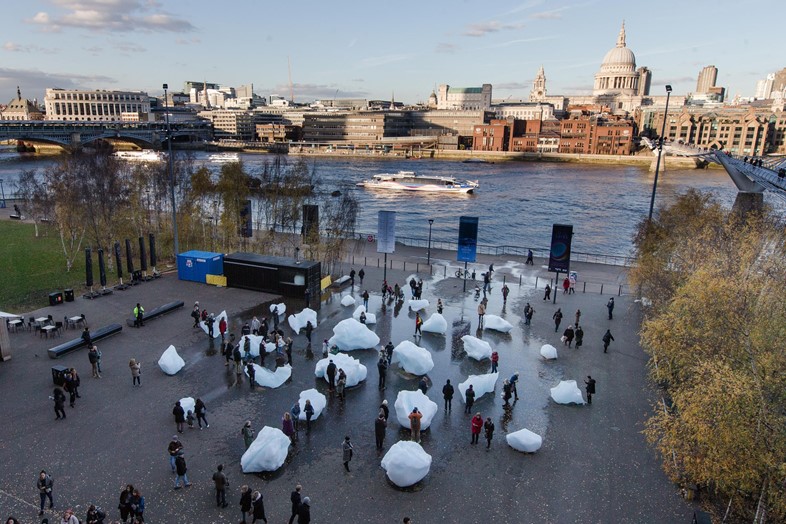
In your essay in the catalogue, you write that artists have often been suspicious of working with feelings, but that Olafur never shies from it. Can you talk more about that?
Mark Godfrey: When I was writing the essay, (I write that) many other people have been very suspicious about working with feelings. They would say look how Donald Trump works with feeling, or how the Brexit campaign worked with feeling, and how often it’s people on the right who mobilise emotions, or fear, often into very reactionary, political goals.
I think other artists are sceptical about working with feeling because they tend to think it’s the right that often trades in manipulating feelings in order to create political reactionary movements. In the 20th century, the worst case, of course, was Fascism, when feelings of great national pride led to support for Hitler. So that’s where some scepticism comes from, but I think Olafur would say ‘no. You can channel them in the right way’.
I also wanted to talk to you about the disruption of the space. Bringing ice blocks from the Arctic to the middle of London is a disruption of that space naturally, the ‘Moss Wall’ is also a disruption.
Mark Godfrey: Well, if you put the ‘Moss Wall’ on the outside of the building, it would be completely different from what the work is (when it’s inside it). The ‘Moss Wall’ works by taking a conventional gallery space, which usually has white walls, is rectangular, is pretty clean, and you cover one of the walls with moss, and suddenly the room is disrupted because something that is organic and is living is coating a whole wall. It’s not about the look of it, the smell of it, or touching it, it’s about the idea that within the conventions of the white cube space, moss is a disturbance that introduces something living into a piece of architecture where you usually don't have anything.
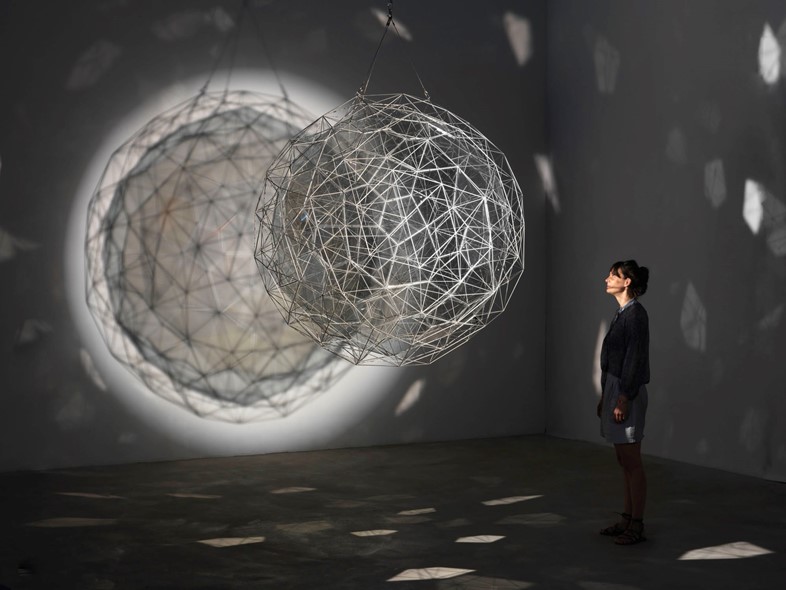
Even with the kaleidoscopes, for example, there’s a disruption in that when we look through them. Because reflections or reflective surfaces, we usually assimilate with clarity or clearness, but with a kaleidoscope, we are experiencing a distortion of reality. Is he is trying to bring about new ways of thinking about the world around us by disrupting what we naturally see?
Mark Godfrey: His claim is that a kaleidoscope gives you a different perspective of the world. In the ones he makes you walk through, you see yourself and the back of yourself at the same time. Instead of being in control of the space you walk through, you lose control. If you walk through a long corridor or enter a large space, you feel like you're the centre (of it), and look around in control from the place in which you stand. If you look at a mirror on the wall, you also see the space behind, but you’re still in control. So with the kaleidoscope, you’re walking through them, fracturing the image into many different planes, you no longer have control and may bring about feelings of vulnerability or just having a different perspective and I think it’s that which he is interested in. The first level of the encounter with his kaleidoscopes are fun, and I wouldn't want to forget that or come across as really pompous, but there’s a second level to it, and that’s also in a lot of his work. So the first level is extremely accessible, great fun, and a lot to enjoy, but there’s a second level where you think about the experience and understand, for instance, that you’re not, let’s say, the king of the experience or in control as much as you would be in a different spatial situation. And that’s what the second level is – it’s where all of Olafur’s ideas come in.
In Real Life runs at London’s Tate Modern until 5 January 2020
